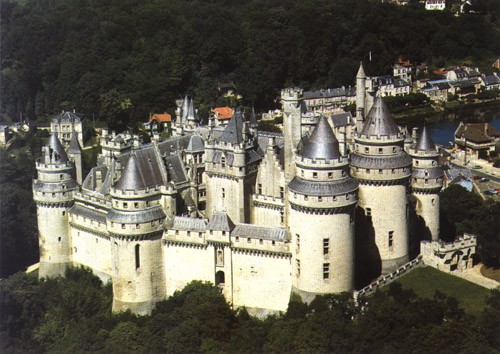This enormous fortress constructed in the 14th century by Louis d'Orléans, the brother of Charles VI, the Château de Pierrefonds, was besieged and then torn down by Louis XIII at the beginning of the 17th century. For almost two centuries the imposing ruins stood unattended – nearly unnoticed. It was not until the end of the 18th century and the beginning of the 19th, with the onset of Romanticism and renewed interest in national monuments and the past, that the Château de Pierrefonds became once again the centre of attention. Painters, draughtsmen and engravers all found in the castle inspiration which matched their enthusiasm for the archaeology of France. Indeed, on the 11th August 1832, Louis-Philippe held a great banquet in honour of the marriage of his daughter to the Leopold 1st of Belgium in the midst of the castle's majestic ruins.
Sold in 1798 as a site of national interest, bought back by Napoleon I in 1810, the château was declared as a building of national historic interest in 1848. The enthusiastic archaeologist, the Prince-President Louis-Napoleon visited the site on the 15th July, 1850. Several years later, on becoming Napoleon III, Louis declared his desire to have the château restored, situated as it was so close to his imperial residence in Compiègne. Hence, Viollet-le-Duc (via the good agencies of Merimée) was chosen as the architect to oversee the restoration of the medieval ruins of Pierrefonds. Initially (1858-1861), the plan was to restore only part of the building, that is, the keep and the large towers, and to shore up the dilapidated walls, so as to leave a 'picturesque ruin'. But in 1861 this plan was abandoned in favour of creating an 'imperial residence', in other words a pleasure palace reserved for court divertissements and for hunting. And so from restoration the plan turned to reconstruction and finally re-creation of the mediaeval architecture.
At Pierrefonds, Viollet-le-Duc in fact provided a concrete example of his general policy of restoration. To restore a building 'is to recreate it in a complete form, indeed a form which might never have existed', he wrote in 1866 in his work Dictionnaire raisonné de l'architecture. Pierrefonds is not fantastical pastiche but rather a free interpretation of a building of the mediaeval period.
The castle forms an irregular rectangular with eight large towers on the perimeter, and on the whole corresponds to what Louis d'Orléans fortress must have looked like. The interior on the other hand shows the aesthetic of Viollet-le-Duc and especially his talents as an interior decorator. The main courtyard, designed in a late-mediaeval/early Renaissance style, gives onto the different parts of the château and the chapel. The keep (not detached but linked to the principal façade) contains the imperial apartments, a design in accordance with the original mediaeval function of the keep as the Lord's dwelling place. The visit begins on the first floor with the reception salon where the Emperor and Empress were to have welcomed their close friends. Beyond this follow on the study, and then Napoleon III's bedroom and that of Eugénie, both set in the Julius Caesar tower. In these rooms, Viollet-le-Duc's ornamental décor comprises sculpted panelling and stencils of figures where illustrations of animals based on those in Mediaeval bestiaries alternate with a profusion of floral motif designs. Indeed with this use of vegetation, the stylisation of the design and with the bright polychrome rendering, the architect can be seen as a precursor (fifty years before!) to the Art nouveau movement so brilliantly illustrated by Guimard and Horta. A recurrent symbol in the decoration is of course the imperial eagle (it appears on the beams, walls and chimneybreasts), and there are in addition friezes which take as their subject the lives of knights of the 14th century.
The main formal hall of the castle, called the 'Salle des Preuses', is remarkable not only for its dimensions (50m long, about 10m wide and 12m tall) but also for the sumptuous polychrome decoration. A room perfectly designed to match the splendour of the imperial receptions intended to be held there, it was also intended to be a giant display case for Napoleon III's private collection of armour, today held in the Invalides. There are two statue groupings at either end of the hall: at the entrance, Charlemagne with a group of prince paladins; and at the other end, a group of nine preuses ('warrior maidens') ornamenting the monumental fireplace – the leader, Semiramis, has the features of the empress Eugénie, and the eight companions were made to resemble Eugénie's ladies in waiting.
Construction costs were more than 5 million Francs, of which 75% was covered by the Emperor's personal fortune. Incomplete on the fall of the Second Empire, the château never received the furniture which Viollet-le-Duc designed for it. On Viollet-le-Duc's death in 1879, his son-in-law the architect Ouradou took charge of the construction work, but this was discontinued in 1885, never to recommence.
Criticised by many as merely a theatrical backdrop, the château de Pierrefonds has always been a subject of controversy. As a heady vision of mediaeval art, the castle symbolises the marriage of science and the irrational, rigorous archaeological correctness and folklore. It is indeed a fairy-tale castle, but one which testifies to the genius of its creator, Viollet-le-Duc, and the proto-post-modern desires of the Second Empire to reconcile history with modernity.
Compiegne Itinerary
Château de Pierrefonds


